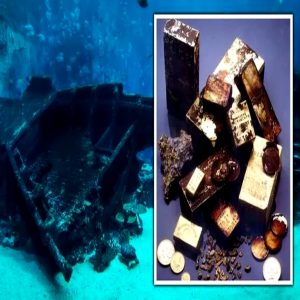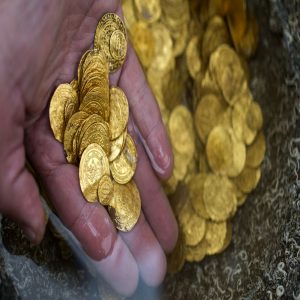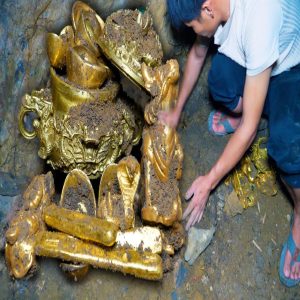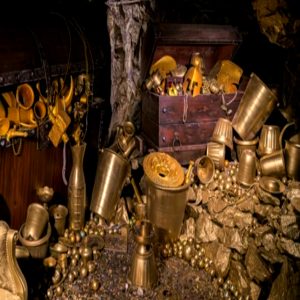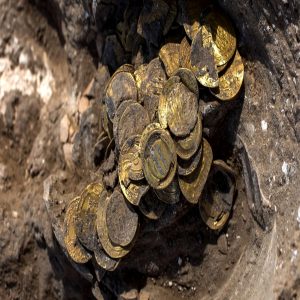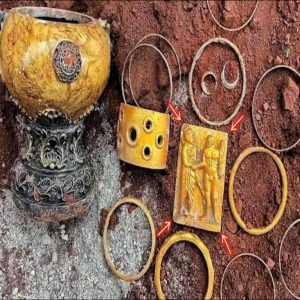Ole Ginnerup Schytz’s first time using a metal detector proved a rewarding one last December when the rookie treasure hunter found a stunning cache of 6th century gold jewelry in a field near the town of Jelling in Denmark.
When the device’s sensors activated, Schytz started digging, unearthing a small piece of twisted metal. “It was scratched and covered in mud,” he told the state television station TV Syd. “I had no idea, so all I could think of was that it looked like the lid of a can of herring.”
The reality was far more exciting: In an astounding bit of beginner’s luck, Schytz had stumbled across no fewer than 22 pieces of gold treasure from the Iron Age, weighing just over two pounds in total. It had been buried for some 1,500 years.
Now, eight months later, the stunning find, which predates the Viking era, has been revealed in all its glittering glory by the Vejlemuseerne in southern Jutland.

Ole Ginnerup Schytz discovered a enormous golden treasure from the Iron Age in a field near Jelling, Denmark, in southern Jutland. Photo courtesy of the Vejlemuseerne, Denmark.
It’s being hailed by experts as one of the largest and most valuable archaeological discoveries in Denmark’s history, comparable to the Golden Horns of Gallehus, a pair of Iron Age artifacts discovered in 1639 and 1734, but stolen and melted down in 1802.
“This is the biggest find that has come in the 40 years I have been at the National Museum. We have to go back to the 16th and 18th centuries to find something similar,” archaeologist Peter Vang Petersen, of Copenhagen’s National Museum of Denmark, told TV Syd.

A piece of the Iron Age golden treasure that a first-time metal detectorist discovered in Denmark. Photo courtesy of the Vejlemuseerne, Denmark, Conservation Center Vejle.
The bulk of the treasure are bracteates, a kind of flat thin medallion with engravings on one side that was common in northern Europe during the Migration Period (375–568). The jewelry is decorated with runes, magical symbols, and religious imagery such as the Norse god Odin, all reflecting delicate craftsmanship of the highest order. Women would have worn the amulets for protection.
Other gold pieces are coins from the Roman Empire, including one from the reign of Constantine the Great, who was in power from 285–337, hundreds of years before the gold was buried in a village longhouse. That suggests a robust trade network across the European continent, while the treasure’s enormous wealth suggests the area around Jelling was a seat of power.
Experts believe the gold was hidden around the time of a large volcanic eruption in the year 536, which triggered widespread famine in Scandinavia. Many of the region’s most significant gold discoveries date to this period, likely because they were buried as sacrifices to the gods by a people desperate to have the sun shine again.
The newly unearthed hoard is set to go on view in a Viking exhibition opening at the Vejlemuseerne on February 3, 2022, before making its way to the National Museum in about a year.
See more photographs from the discovery below.

The Iron Age golden treasure that a first-time metal detectorist discovered in Denmark. Photo courtesy of the Vejlemuseerne, Denmark.

A first-time metal detectorist discovered this golden treasure from the Iron Age in a field near Jelling, Denmark. Photo courtesy of the Vejlemuseerne, Denmark, Conservation Center Vejle.

The Iron Age golden treasure that a first-time metal detectorist discovered in Denmark. Photo courtesy of the Vejlemuseerne, Denmark.

A first-time metal detectorist discovered this golden treasure from the Iron Age in a field near Jelling, Denmark. Photo courtesy of the Vejlemuseerne, Denmark, Conservation Center Vejle.

A piece of the newly discovered Iron Age golden treasure from Denmark depicting the Roman emperor Constantine. Photo courtesy of the Vejlemuseerne, Denmark, Conservation Center Vejle.

A first-time metal detectorist discovered this golden treasure from the Iron Age in a field near Jelling, Denmark. Photo courtesy of the Vejlemuseerne, Denmark, Conservation Center Vejle.

A piece of the newly discovered Iron Age golden treasure from Denmark. Photo courtesy of the Vejlemuseerne, Denmark, Conservation Center Vejle.

A piece of the Iron Age golden treasure that a first-time metal detectorist discovered in Denmark. Photo courtesy of the Vejlemuseerne, Denmark.

A piece of the newly discovered Iron Age golden treasure from Denmark depicting the Norse god Odin. Photo courtesy of the Vejlemuseerne, Denmark, Conservation Center Vejle.

The Iron Age golden treasure that a first-time metal detectorist discovered in Denmark. Photo courtesy of the Vejlemuseerne, Denmark.

Ole Ginnerup Schytz discovered a enormous golden treasure from the Iron Age in a field near Jelling, Denmark, in southern Jutland. Photo courtesy of the Vejlemuseerne, Denmark.
